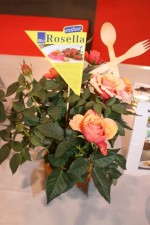IPM Essen Takeaways

As a grower, your tradeshow travel budget may be restricted to OFA Short Course, a couple of regional tradeshows and maybe one show within your own state – if that. But if you have the means to visit IPM Essen at least once over the next few years, I’d encourage you to go for it.
The biggest advantage of attending Essen is you’re exposed to hundreds of new vendors and thousands of new ideas you can take back and put into your business. Some of the Essen exhibitors may not serve the United States directly, but a number will. And if you contact a broker about buying a new variety, series or product, they’re likely to do the heavy lifting to make that product available to you. (Or, the product may already be available to you, but perhaps under a different name.)
Having left the show just a few days ago, there’s still so much for me to digest. But here are a few takeaways I pulled from IPM Essen 2012.
More Dye-Infused Action
Colored cacti and kalanchoes were among the dye-infused plants I saw on display at Essen, showing more growers see an opportunity with the technique. I spoke with John Langeslag, the business development and account manager for Allsenza, a group that represents a dozen anthurium growers in Europe who are dabbling with dye-infused Princess Alexia anthuriums. ‘Princess Alexia Blue’ was on display at the tradeshow, and Langeslag reiterated what we’ve heard countless times about dye-infused plants.
“Some modern consumers like [‘Princess Alexia] Blue,’ but it’s not for everyone,” he says. “It’s mostly for the younger and modern consumers.”
KP Holland is involved in the dye-infused plant area, as well, producing colored Rosalina kalanchoes in Blue. Bert van Spijk, an account manager for KP, says the company that’s licensing growers to produce dye-infused orchids is called Van Geest.
Mini, Mini, Mini
We see a few signs of miniature plant momentum here in the U.S. with the introduction of tiny orchids (e.g., Just Add Ice at TPIE) and poinsettias (e.g., Peace Tree Farm’s unique items). But mini is mainstream in Europe, where consumers have significantly smaller spaces to garden.
Seems to me there’s opportunity to at least explore miniature plants more in depth here in the U.S. Check out the photos of the mini kalanchoes from Mini Weltmeister in the slideshow above for one cool concept.
Another grower bringing miniatures to the European market is Karma Plants, which grows Joli and Sierra miniature anthuriums bred by Anthura. Among the advantages of the more miniature, 4-inch anthuriums are lower transport costs and additional space on benches.
“Species are now specially bred for these small pot sizes,” says Maurice Langelaan, a salesman for Karma Plants.
Hello To Hello Kitty
Hello Kitty first caught my eye two weeks ago at the Tropical Plant Industry Exhibition in Fort Lauderdale, Fla. Delray Plants reportedly won the licensing rights to market plants with Hello Kitty point-of-purchase materials. KP Holland is playing a similar role in Europe bringing Hello Kitty to market with kalanchoes. Other growers will be licensed to handle other crops for the brand.
I’m not a Hello Kitty fan by any means and I didn’t realize Hello Kitty had been around for a few decades, either. But the idea of channeling a well-known brand like Hello Kitty and slapping it onto random merchandise is intriguing. Perhaps we’ll see Paul Frank poinsettias next.
Marketing Concepts
Hello Kitty is one way to market your plants. Essen shows there are no bounds to a grower’s creativity, though.
Some of the coolest and simplest marketing concepts I saw in Essen were snow-covered helleborus for the winter holidays; smart use of traditional gift bags for blooming potted items; and a more innovative gift bag concept with openings on the sides of bags for grab and go. Edible flowers and cross-merchandising flowers with scented oils extracted from plants are two other inspiring concepts I saw (see the photos above).









